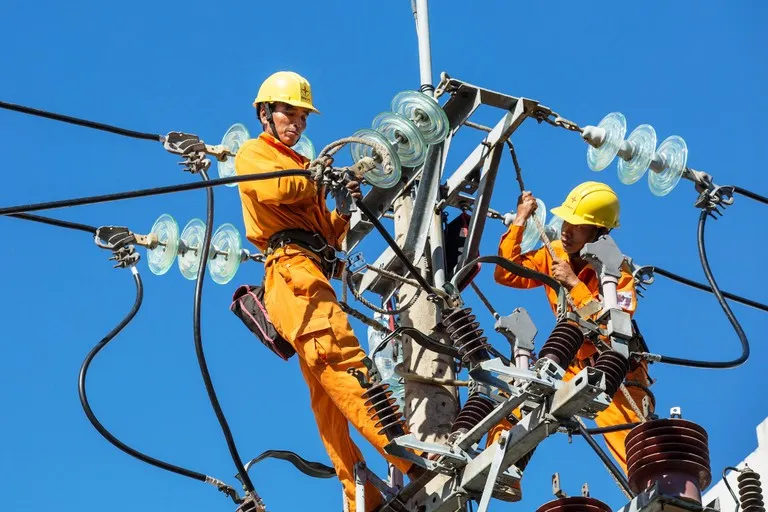
Accepted average price
According to Article 4 of Decision 24/2017 issued by the Prime Minister, the average electricity price is calculated on the basis of price at factories and in import of electricity, plus normal profit from power plants providing ancillary services including trial run costs, costs of purchasing electricity transmission services with regulated profits, purchasing distribution services with fixed profits, and the general management cost of Vietnam Electricity (EVN). The average electricity price also includes losses due to exchange rates, costs of purchasing service of regulating the power system, operating electricity market transactions, and costs of regulating the electricity market.
The average electricity price is calculated for all four groups, which are: industrial production, administrative and non-business sectors, commercial and business sectors, and electricity for daily consumers. In many countries, the average retail price of electricity for daily consumers is higher than the average electricity price, which is aimed at compensating for production, promoting Foreign Direct Investment (FDI), and for increasing competitiveness in manufacturing and business sectors. However, it is necessary to remain transparent in electricity prices for domestic consumption, and for production, commercial businesses, administrative and non-business sectors.
The current average retail price of electricity under Decision 648/QD-BCT of the Ministry of Industry and Trade was approved by the Government and applied from 20 March 2019, at a regulated rate of VND 1,864.44 per kWh. On this basis, the retail price of electricity for daily consumption was determined at VND 2,018 per kWh. This price has been acceptable to the consumer, where only one price is applied, and whoever uses less will pay less, while whoever uses more will pay more, ensuring a high level of fairness.
Providing efficient supply
In the market economy, EVN is just an enterprise like any other business. Hence, state management and social management needs to be separated from the functions of an enterprise. EVN should only focus on its main job of producing an efficient supply of electricity, look for ways to lower the cost of electricity, reduce the amount of electricity waste in power transmission and distribution, and ensure that a high quality of environmental protection is maintained. For poorer households, there are now welfare subsidies from the Government. Accordingly, poor households or households with social policies receive support for clearing electricity bills, though the support is more or less dependent on factors decided by the Government.
The average ladder price of electricity is to encourage consumers to use electricity economically. This is considered necessary as people now have increased high incomes, and demand for electricity has risen while electricity production has remained the same. The total electricity sales of EVN by average ladder price must be equal to the average retail electricity price for daily consumption specified by the Government, and multiplied by total electricity consumption of user. EVN is not allowed to receive revenue greater than the total electricity consumption of daily consumer calculated at the average retail price of electricity.
Remove inadequacies
In the current five-tier electricity price proposal, there is only one step below the regulated average retail price of electricity for daily consumers. The other steps are priced above the average retail electricity price for daily consumers, with the fourth and fifth steps being very high. The Ministry of Industry and Trade needs to be more transparent on this high pricing, as this makes the actual average retail electricity price higher than the average retail price of electricity for daily consumption as regulated by the Government. Speaking precisely, it is necessary to have specific statistics on each ladder of electricity pricing, as well as of power consumption usage of average households in the past.
Usually, when the actual average ladder price is higher than the regulated average retail price of electricity, EVN is entitled to this difference. Moreover, when the weather is too hot or too cold, or during holidays or Tet Lunar New Year, the household electricity consumption increases, and EVN pockets the big difference. The calculation of ladder electricity prices also does not solve the lack of transparency in electricity pricing. In essence, the way to calculate ladder electricity prices is to limit people from using a lot of electricity, just like we use special consumption taxes to regulate goods that the government does not want to encourage. Under this tax, the Government imposes progressive tax rates on use of certain goods. This is intended to remedy negative impact of goods on consumers, health, or environment.
By using ladder electricity pricing, the difference in actual collection rate and average retail price of electricity converts into profits for EVN. Hence, if this difference is deducted from government budget and used for investment of infrastructure development for the power sector it will be reasonably justified. Furthermore, investment in research, application of modern and energy saving production methods, and development of renewable energy resources are all very lucrative and high production possibilities for the future.




















